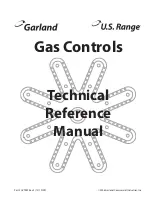
6
MAKE GAS CONNECTIONS
WARNING:
Never reuse old flexible connectors. The use of old flexible
connectors can cause gas leaks and personal injury. Always use new flexible connectors
when installing a gas appliance.
WARNING:
Do not use a flame to check for gas leaks. Use liquid leak
detector at all joints and connections to check for leaks in the system.
A.
Install a manual shut-off valve in the gas supply line in an easily accessible location.
B.
Know how and where to shut off the gas supply to the range.
C.
Shut off gas supply before removing an old range. Leave it off until hookup of new range
is finished.
D.
Because solid pipe restricts moving the range, we recommend use of a C.S.A.-certified
flexible metal appliance connector.
E.
Before making gas connections, make sure that the oven shut-off lever (visible at the back
of range) is in the open position.
F.
To prevent gas leaks, put a pipe joint sealant or Teflon
®
tape on all male threads.
NOTE:
Make sure sealant or tape is compatible with Natural and LP gases.
G.
Install 1/2”
flare union adapter to the 1/2” NPT elbow on pressure regulator.
H.
Connect flexible gas line to flare union.
I.
Move range into approximate position and connect flexible gas line to gas supply line with
proper flare union adapter.
J.
When you are finished making connections, be sure that all range knobs are turned to OFF
before you open the main gas supply valve.
K. CHECK FOR LEAKS.
Turn the gas supply on and use a liquid leak detector (soap solution)
at all joints and connections to check for leaks.
Do not use open flame to look for leaks.
Be sure all leaks are stopped before lighting burners.
Gas supply to top
burners
Pressure regulator
as seen from front
of range
Gas
supply
to oven
Oven shut-off lever
shown in the open
position
NOTE:
When screwing
on the flare union adapter,
hold the gas inlet firmly
with a wrench.
Pressure
regulator
Gas supply
line
90° street
elbow
Shut-off valve Flexible gas line
7” (17.8 cm) Max.
Flare union
7
ANTI-TIP DEVICE INSTALLATION
To reduce the risk of tipping the range, the range must
be secured by a properly installed anti-tip bracket. See
installation instructions shipped with the bracket for
complete details before attempting to install.
To check if the bracket is installed and engaged
properly, remove the storage drawer or kick panel and
look underneath the range to see that the leveling leg
is engaged in the bracket. On models without a storage
drawer or kick panel, carefully tip the range forward.
The bracket should stop the range within 4 inches
(10.2 cm). If it does not, the bracket must be reinstalled. If the range is pulled from the wall for any
reason, always repeat this procedure to verify the range is properly secured by the anti-tip bracket.
Never completely remove the leveling legs or the range will not be secured to the anti-tip device
properly.
8
SLIDE RANGE INTO OPENING
A
. Position the range in front of the cabinet opening. Make sure that the cooktop
that overhangs the countertop clears the countertop. If necessary, raise the unit
by lowering the leveling legs.
B
. Push while lifting the range into the opening until the range is within 2” (5.1 cm)
of engaging the anti-tip bracket. Remove the protective channel from the side
of glass (if provided).
C
. Using the adjustable pliers or wrench, carefully screw in the back leveling legs until the cooktop
overhang touches the countertop. Then carefully screw in the front two leveling legs until the
cooktop overhang touches the countertop.
D
. Carefully push the range into the opening until the
unit is fully seated into the cabinet. The back cooktop
overhang should cover the cutout opening. Plug the
range cord into the receptacle. Locate the flexible
gas line in the back of the range in a manner that it
will not touch or be moved by the drawer.
Position gas line so that there is no
interference with the storage drawer
STORAGe dRAWeR
SIDE VIEW
ReAR
WALL


























